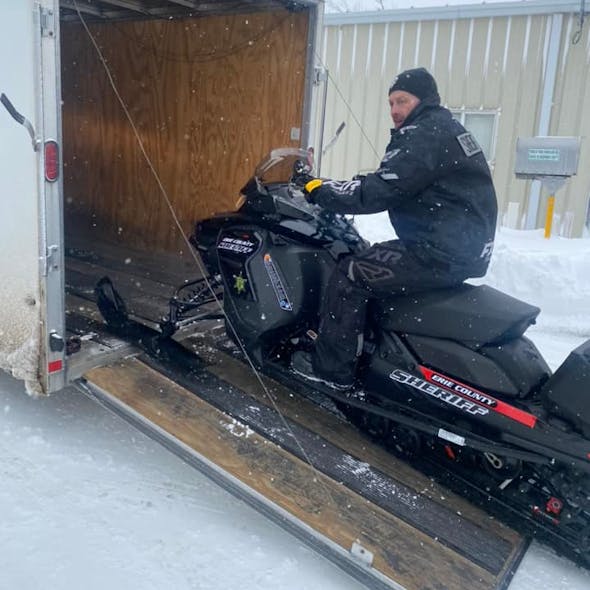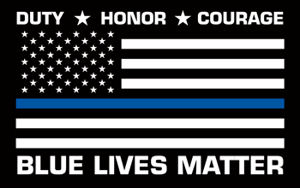Feb. 21, 2023 The Erie County Sheriff’s Special Operations Division is made up of “problem solvers” tackling “no-fail missions,” with members helping during a recent blizzard when others couldn’t, officials say.
By Sandra Tan Source The Buffalo News, N.Y. Distributed by Tribune Content Agency, LLC.

It was 6 degrees outside when about 20 men gathered by a frozen lake at Chestnut Ridge Park this month. A chainsaw cut a room-sized rectangular hole through the thick ice, exposing the frigid water beneath. Several underwater rescuers in neoprene dry suit gear hung out nearby to save anyone who might need saving.
Then it was time for everyone else to jump in, one at a time, and find a way to get themselves out.
Cold weather rescue training comes with the job for many members of the Erie County Sheriff’s Special Operations Division. When Sheriff John Garcia says his office never stopped responding to emergency calls during the Christmas week blizzard, even at its height, he’s mainly referring to this group.
Members of this unit were out at the storm’s worst at a time when most other first responders, including other police officers and sheriff’s deputies, were sidelined. They were sent out in teams, driving snowmobiles, all-terrain vehicles and large trucks.
“If you want an overarching description of this group of individuals, it’s expert problem solvers,” said Capt. Warren Hawthorn, operational commander for the Special Operations Division. “They solve problems in real time in austere locations and austere environments.”
Many Special Operations officers working the first shift stayed on duty for more than 30 hours, from the morning of Dec. 23 until the afternoon of Dec. 24, when a second shift took over.
Law enforcement agencies at all levels have trouble recruiting members. But the county’s Police Services Division — of which Special Operations is a part — enjoys more recruitment success because of the diversity of higher level, specialized police units.
Those units include the helicopter pilots in the Aviation Unit; the bomb squad; SWAT; Underwater Recovery and Rescue divers; the Marine/Snowmobile Unit, which includes both snowmobile and boat operators; the Mobile Response Unit that provides medical-related police assistance; the K-9 Unit; and the Crisis Management Team that covers hostage negotiators.
Many Special Operations candidates participate in competitive tryouts that include fitness tests, skills testing, disciplinary record review and interviews with the candidates, though the lack of diversity in the Sheriff’s Office, which is common among many police agencies, is also an issue here. Women are greatly outnumbered or absent from many Special Operations units and no African American deputies exist in the Special Operations Division.
Beyond that, however, the Sheriff’s Office has the greatest number and broadest scope of people who can tackle “no-fail missions,” said Special Operations Chief Brian Britzzalaro.
“They’re called special for a reason,” he said.
Training
During the worst of the blizzard, Hawthorn said three main Special Operations units were on the ground working. They included the snowmobile, SWAT and bomb squad units. Those groups were chosen because they have all had extensive cold weather training. Many are cross-trained, have emergency medical certification and are among the most physically fit.
Last month, members of the division were sent to Colorado to spend a week in the Rocky Mountains for cold weather training and endurance over land.
And this month, when Buffalo Public Schools were closed due to the extreme cold, 20 Special Operations members, as well as a few members of the Hamburg Police Department and U.S. Border Patrol, participated in ice breakthrough extrication exercises. An outside trainer with a military background tied a red cord around each unit member before he jumped into the bitterly cold lake behind the Commissioner’s Cabin at Chestnut Ridge Park.
Each unit member had three tries to pull himself out before the trainer assisted with the rope. If that failed, divers with the Underwater Recovery unit would jump in and haul the trainee out. The key to self-extrication is to stay as horizontal to the ice as possible, kick forward and to use a knee to help crawl out onto the ice, the trainer said.
Anyone trying to get out from a vertical position, perpendicular to the ice, risks being caught by currents.
“What we don’t want to do is get caught under the ice,” said Ivan, the outside trainer, who asked that his last name not be used for security reasons.
The members jumped in fully dressed with winter hats and hiking shoes, to mimic conditions if they were to fall through the ice unintentionally and need to save themselves. Most dragged themselves out of the water on the first try.
Blizzard conditions
No cold-weather training could mimic the conditions posed by the blizzard. Members were busy either bringing up tracked vehicles and snowmobiles that were parked at Chestnut Ridge and Emery parks, or rescuing stranded people, mostly along the Main Street and Transit Road corridor where East Amherst meets Clarence.
Deputies and sergeants working during the blizzard described scenes of a post-apocalyptic movie, maneuvering around frozen and abandoned vehicles, firetrucks, ambulances and snowplows scattered across the roadways at different angles. But those out in the height of the storm were aided by the fact that Erie County owns six snowmobiles.
The Sheriff’s Office also had two utility vehicles with tracks similar to what is seen on tanks. Two more would later be provided by the Parks Department.
The units had to respond to rescue calls as well as retrieve stranded first responders. Aside from the challenges all first responders faced in maneuvering around stuck and abandoned vehicles, the teams were forced to make multiple trips to rescue people because of the limited seating capacity of their vehicles.
In many instances, first responders were left waiting for help because deputies and officers would encounter more desperate people needing assistance along the way.
Sgt. Ben Pisa recalled trying to rescue one deputy who adamantly refused to leave her stuck vehicle until two parents, four children, a grandfather and a dog were retrieved from their van and taken to safety. The van occupants were dressed in their Sunday best and completely unprepared for the blizzard, said the eight-year SWAT veteran.
Deputy Kyle Hoffman, a six-year SWAT member, recalled being sent to Buffalo’s East Side to rescue parents with an 18-month-old child, who had been trapped in a car for 16 hours. They were apparently from out of town and had come to the area to visit Children’s Hospital. At least four others were also stuffed in the car because it still had gas and heat.
“Having kids of my own, it kind of hit home a little bit,” Hoffman said.
It took two trips to bring the parents and child to a shelter. The officers also helped the others get access to an industrial building nearby for refuge.
Even though the training already undertaken by Special Operations members didn’t specifically cover blizzard conditions, it still came into play, Pisa said. The “stress inoculation” training undertaken by rapid response unit members involves repeated exposure to extreme situations.
“That the important part,” he said. “It’s keeping your mental faculties when things are going wrong.”
Britzzalaro, who spent his time in the county’s Emergency Operations Center, said one of the most valuable things the sheriff’s response team did was bring hope to people when it seemed hope was lost.
As the worst of the storm wound down, more Sheriff’s Office responders were involved in cleanup efforts and transportation of essential personnel and residents with immediate medical needs.
Britzzalaro recalled traveling into the city with Undersheriff William Cooley on Christmas Day to pick up a man with Stage 4 cancer. The man had gone to visit his daughter in the city and was unable to make it home. After finding all paths to the daughter’s house blocked, Cooley flagged a high lift operator and got him to clear a path to the house.
It took the chief and undersheriff two hours to bring the man back to his own home in East Aurora. They would eventually learn that the man died in his home two days later. But the family was grateful that he could pass his last days in his home with his wife.
“We didn’t rescue anybody,” he said, “but it’s just one of those stories that gets you.”

